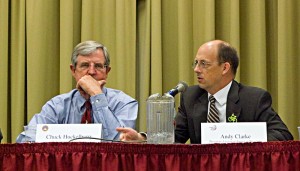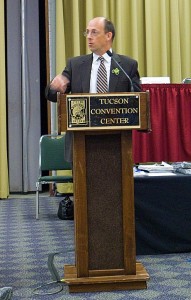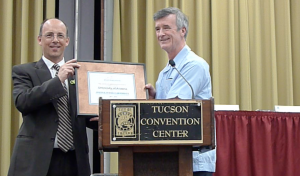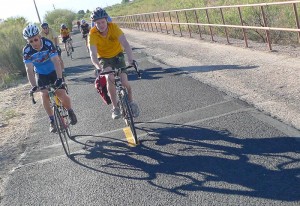
After a long day of touring sections of the Urban Loop and attending regional planning meetings, the League of American Bicyclists president Andy Clarke told more than 100 Tucson cyclists that in order to achieve platinum bicycle friendly status there need to be more people on the road.
Clarke said during the presentation they are specifically looking for cyclists who are replacing car trips with a bicycle, rather than purely recreational bicycling.
“We need to make sure Tucson isn’t just a good place to ride — but is the best place to ride, and frankly the best option for people to make more of their everyday trips,” Clarke said. “That is the real challenge and what will truly propel you to platinum. You’ve got great infrastructure, you’ve got great education programs, we need to just see more people out there riding.”
Clarke’s comments largely mirrored what he told Tucson Velo in an interview on Monday, but added it isn’t all about commuting to work, rather the shorter trips people take. He said 40 percent of all the trips in the United States are less than two miles and 66 percent of those are made by car.
“We need to change that,” he said. “We need to focus on short, manageable, easy trips and encourage people to make them by bike. We want to not obsess about the journey to work number particularly in this region perhaps because so many of you are beyond work shall we say.”
 He said only 15 percent of all the trips in the U.S. are work trips and said Tucson should also be focusing on the other 85 percent.
He said only 15 percent of all the trips in the U.S. are work trips and said Tucson should also be focusing on the other 85 percent.
“Those are actually much easier to get people to make by bike because they don’t have to wear the suit and the tie and worry about their hair if that is an issue for them,” he said while rubbing his balding head.
Clarke had suggestions for how to get people on their bikes to replace the car for the short trips they make.
He suggested doing monthly or weekly ciclovias and creating an individualized marketing program to help people feel comfortable riding their bikes.
“These are the kind of transformative events that we need to see not annually – sorry for the folks that spent a lot of time working on it once a year — we need to see this happening every month, every week,” he said to a round of applause. “It will open people’s eyes to what is possible in their community in a way nothing else does. If you couple this with a kind of low-cost information program to give people that last one or two pieces of information they need to get their bikes out and start riding, those are the two things that are going to get a host of people back out on their bikes here in the Tucson region and that will be what propels you to platinum.”
UA receives bicycle friendly award
 Just before Clarke spoke, he presented University of Arizona president Robert Shelton with an award recognizing the UA as a silver-rated bicycle friendly university.
Just before Clarke spoke, he presented University of Arizona president Robert Shelton with an award recognizing the UA as a silver-rated bicycle friendly university.
Shelton, who spent 14 years at UC-Davis, one of the most bike friendly universities, said he was pleased with the award.
“We are thrilled to get on the medal stand, if you will, with the silver, but we have a long way to go,” Shelton said. “There is a lot more we can do.”
He said this is only the start and the UA will make sure bike usage is part of their overall vision despite the budgetary constraints.
“There are a lot of things you can do that you don’t have to spend a lot of additional money,” Shelton said. “You have ways of encouraging bike usage. You could argue one way to encourage bicycle usage is that parking gets more expensive. There are carrots and there are sticks.”
Clarke tours sections of Urban Loop

Yesterday morning, Clarke toured portions of the Urban Loop. The ride was hosted by Pima County’s bicycle and pedestrian program manager, Matt Zoll.
The ride started at Craycroft Road and the Rillito River Path and headed west. The group toured a portion of Mountain Avenue’s buffered bike lanes and then returned to the river path.
Eventually the riders made their way to the Santa Cruz river path and headed south toward downtown.
Check the photo below for images from the ride.











Speaking of encouraging more frequent trips for short distances:
http://2milechallenge.com/
Seems like a great, free way to donate to charity and think about the number of trips you’re making.
Speaking of encouraging more frequent trips for short distances:
http://2milechallenge.com/
Seems like a great, free way to donate to charity and think about the number of trips you’re making.
One of the things I think that American cycling needs to overcome is the focus on athleticism. As in, if you’re out there riding a bike, you must be in training for some sort of competition.
Now, we all know that most utilitarian bicyclists aren’t interested in competition. Except, maybe, for coolness points. (How’s everyone doing on their Daily Coolness Points? Got any yet?)
In the minds of the public, we’re still viewed as athletes. Even when that’s the last thing we’d like to be perceived as.
I’d like to see some TV ads showing our bike routes. Each ad would show a time compressed trip along one route with text popping up to designate major cross streets. A shot of a map at the beginning and end would give context. I think it would show people that we have ways of getting around other than on the major roads.
They could have other ads with mini interviews with bicycle commuters and folks who run their errands on their bikes.
Just a few thoughts.
This is the great dichotomy within the cycling community. The ‘competitive’ riders don’t see the utilitarian rider’s requirements as real needs. We don’t speak with one voice in this area; there’s little mutual support. Even identifying ourselves within the group is a mixed bag.
At the meeting, a person from Madison, WI described favorably the commute there and complained about the commute here. It is difficult for some riders to percieve the danger that other riders sense from cars passing 4-5 feet away going 40 MPH. I think we are torn between acknowledging that sense and educating past that sense.
It never seems to get mentioned that Copenhagen probably did not have the huge car culture hurdle to deal with when creating its bike-centric transportation system. It would have been good if Andy had elaborated about how some communities had increased their ridership numbers so quickly and what has led to decreasing numbers in Davis, CA. Maybe he did that in the smaller group discussions.
Yesterday, Clarke mentioned Portland’s “Smart Trips” and individualized marketing as a way to give people the “last steps” to get on their bikes and ride. What he didn’t mention was that this program was part of Portland’s massive publicity campaign that cost $250,000. Pima and Tucson must increase ridership without this kind of money, and WE WILL! Perhaps TV and Radio stations will do Commercials/PSAs for free like the ones 3Wheeler mentioned!
I was thinking about the woman from Madison, Wi. She said her options were Pima, Speedway or Broadway. That made me wonder if she had heard of Third Street as an option.
We talk a lot about education, but it’s always about how to ride in traffic or how to protect yourself.
That kind of education doesn’t get people on bikes. That sort of educationed needs to be secondary.
The primary education needs to be here are the easier routes to use. Here is where the easier crossings. Get’em riding then start building their confidence.
Living near 4th and Elm, I rarely ride my bike to any businesses in the Grant and 1st ave area. I go to businesses along University and 4th Ave instead. Sometimes I would really rather shop at Fry’s or eat at Yamato Japanese instead of heading south. The problem is that certain roads act like giant walls to pedestrians and cyclists.
Bike boulevards are a nice start, but there either needs to be infrastructure changes to help me get to the same supermarkets and shopping centers that cars are flocking to, or there needs to be a change in where and how businesses are placed. Would people start walking and biking to neighborhood grocery stores tucked along more minor streets? Can we figure out ways to give incentives to businesses opening up along bike/ped corridors instead of major intersections? What policy changes need to happen to make sure a small Trader Joe’s or Whole Foods or Albertson’s or local grocery store ends up at 6th and Grant, or Ft Lowell and Fontana instead of the Tire Corral?
KXCI does quite a few PSAs at no cost to the organizations. The ones they did to promote Cyclovia were quite good.
Point of history: Davis, California was already known as bike-topia back in the mid-1970s. So, to be fair, they’ve had something like a 40-year head start.
I live on the east side, and there seems to be hardly any utilitarian/errand cycling out here. There is a CVS store I ride my bike to, and their bike rack is in back of the building, off an alley. So I lock my bike near the front door to a shopping cart rack. Ditto for lots of shopping centers and stores out here; bike racks hardly exist, and if they do, they are way out back somewhere. But the big issue is that suburbanites don’t think of riding to the store, bank, etc. I don’t know how you encourage more people to do that. I noticed a month ago that a Sunflower Market in Tempe?? had some type of giveaways to those who rode their bikes to the store.
I’m with ya, James.
Living near 4th and Seneca, I rarely ride to the Frys store or any of the restaurants on Grant. Instead, I don my walking shoes and hoof it over there.
Why? Because it’s easier to be a pedestrian than a bicyclist. Even in that Frys parking lot, which can be a real challenge to navigate on foot. (Seems that, when I’m on the bike, I have this invisibility force field. Especially to the drivers entering and exiting Frys Fuel.)
As for 4th Avenue, I truly enjoy riding down that street, even if I need to be on my toes at the 4th/University light rail obstacle course. Not to mention the bar district. Gotta watch it there too.
Businesses like to be assured of traffic. Even potential traffic gets their attention. Everything is being orchestrated along 4th Ave. and downtown based on the potential traffic created by the streetcar. What form of bicycle route infrastructure can compete with that huge investment? Bike boulevards are untested in Tucsonan eyes and it seems the city is willing to sacrifice a de facto bike boulevard to track hazards. This makes it hard to discern how the city feels about bikes really.
I agree with tucsonvelo above that education for utilitarian cycling will have to be on how to use the existing infrastructure….a shifting of the mind-set on how to get someplace on a bike as opposed to by car. What I mean is routes are habits. When I occasionly drive somewhere, I use the same routes I bike rather than the usual car routes.
When Andy Clarke uses Tucson as an example to other communities, it’s obviously not for our commuting numbers. It’s so baffling how places that have a climate deficit for cycling can do so well with those numbers. The first thing he mentioned about Tucson in his talk yesterday was our climate advantage. Everybody always connects those two things. Maybe we are not right to chase other people’s numbers.
The truly mighty Alan Barnard over at Ecovelo has a timely op-ed piece today:
“Baby Steps”
at:
http://www.ecovelo.info/2011/05/17/baby-steps-2/
In follow up comments, Alan writes:
“Probably the best place to check for bicycle training courses is on the League of American Bicyclists’ “Bike Education” page: http://www.bikeleague.org/programs/education/ You might also check with your local bike shops and city parks & recreation department.”
So we go to LAB’s site, find “Find Courses or Instructors by State”
at:
http://www.bikeleague.org/programs/education/course_schedule.php
and select Arizona, and, yes indeed, one will find that there are LAB certified Instructors in the Old Pueblo. This info isn’t getting out in Tucson/Pima.
Andy Clarke’s comments about offering to take that neighbor or co-worker out for a short ride, and offer to help them dust off and tune up their bike beforehand, resonated most with me.
While “Smart Trips” has proven successful in places like Portland, Mary Reynolds is right to point out that we can’t wait around for that kind of a budget. It’s up to us to spread the word and help one of the “interested, but concerned” get on a bike.
When I first moved to Tucson (5 years ago) it wasn’t immediately apparent to me where the safest places to ride were- and I am the daughter of Tucson’s first Bicycle Coordinator! I learned by riding with other folks- the Tuesday Night Ride, El Grupo- who taught me. If we really want to see more people riding short distances on bikes, we should all try to offer that opportunity to at least one other person this year.